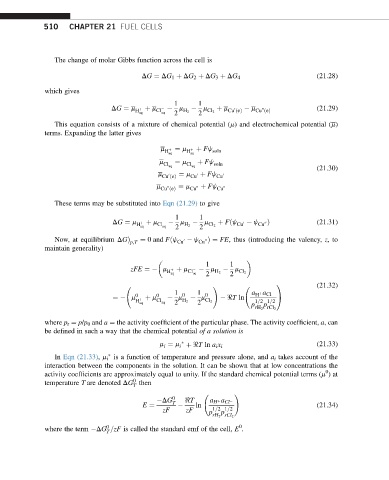Page 517 - Advanced thermodynamics for engineers
P. 517
510 CHAPTER 21 FUEL CELLS
The change of molar Gibbs function across the cell is
DG ¼ DG 1 þ DG 2 þ DG 3 þ DG 4 (21.28)
which gives
1 1
DG ¼ m H þ þ m Cl m m þ m 0 m 00 (21.29)
aq aq 2 H 2 2 Cl 2 Cu ðeÞ Cu ðeÞ
This equation consists of a mixture of chemical potential (m) and electrochemical potential (m)
terms. Expanding the latter gives
m H þ ¼ m H þ þ Fj soln
aq
aq
m Cl ¼ m Cl þ Fj soln
aq aq (21.30)
m 0 ¼ m 0 þ Fj 0
Cu ðeÞ Cu Cu
m 00 ¼ m 00 þ Fj 00
Cu ðeÞ Cu Cu
These terms may be substituted into Eqn (21.29) to give
1 1
DG ¼ m H þ þ m Cl m H 2 m Cl 2 þ Fðj Cu 0 j Cu 00Þ (21.31)
2
2
aq
aq
Now, at equilibrium DGÞ ¼ 0 and Fðj 0 j 00Þ¼ FE, thus (introducing the valency, z,to
p;T Cu Cu
maintain generality)
1 1
zFE ¼ m H þ þ m Cl m H 2 m Cl 2
2
2
aq
aq
(21.32)
1
!
1 0 1 0 a H þa Cl
0
0
¼ m þ þ m m m <T ln A
H aq Cl aq 2 H 2 2 Cl 2 1=2 1=2
p
p
rH 2 rCl 2
where p r ¼ p/p 0 and a ¼ the activity coefficient of the particular phase. The activity coefficient, a, can
be defined in such a way that the chemical potential of a solution is
(21.33)
i
i
m ¼ m þ<T ln a i x i
In Eqn (21.33), m i is a function of temperature and pressure alone, and a i takes account of the
interaction between the components in the solution. It can be shown that at low concentrations the
0
activity coefficients are approximately equal to unity. If the standard chemical potential terms (m )at
0
temperature T are denoted DG then
T
!
DG 0 T <T a H a Cl
þ
E ¼ ln (21.34)
zF zF p 1=2 1=2
p
rH 2 rCl 2
0
0
where the term DG =zF is called the standard emf of the cell, E .
T

